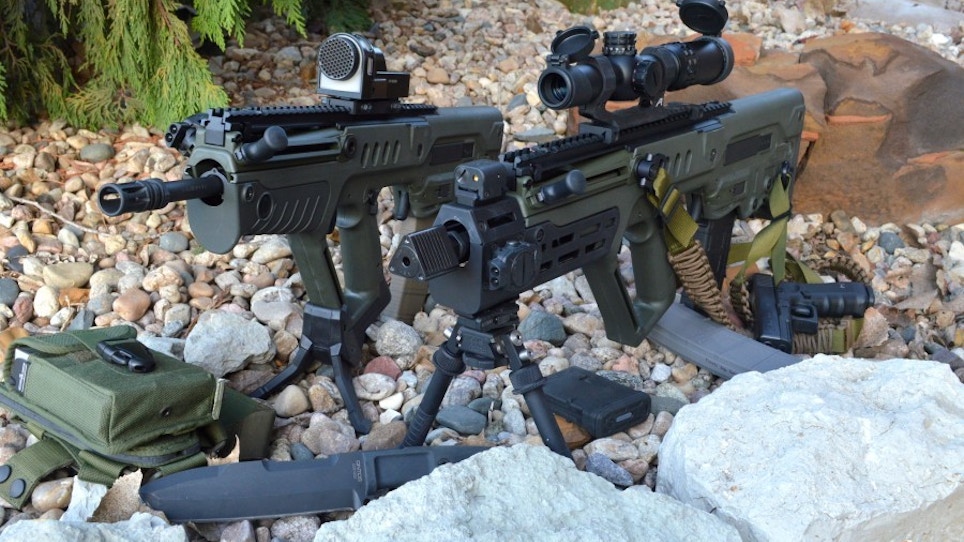Since the much anticipated introduction of the IWI Tavor in the United States, the rifle has been something of a “playmate of the month” for lots of gun magazines and websites. Since the US versions of the bullpup semi-auto rifle hit our shores, Tavor has been called a lot of names — ranging from the ugliest rifle made to winner of the NRA’s 2014 Golden Bullseye Rifle of the Year.
How shooters have used the Tavor runs the gamut, with some matching the Israeli Defense Forces style. Other owners feel more comfortable running the rifle like an AR and make modifications to help the Tavor feel more like an AR.
No matter how it’s shot, the Tavor has proven its long-term reliability. I’ve sent over 12,000 rounds down the barrels of three separate Tavors and have more faith in the reliability of a Tavor than I do with any of my AR-15s. In a torture test of my original Tavor, I documented over 9,000 rounds of problem-free feeding during a 12-month period — all without any additional lube or cleaning.
Just How Popular Is The Tavor?
Looking back over the last two years, the Tavor’s reliability is well established and it’s a consistently accurate rifle. At the same time, the IDF have demonstrated through combat testing that the Tavor is more than just a cool design. It has become popular enough for some local police departments to issue them to their cops — including ones in Kansas, New Jersey and Pennsylvania — due to its size and its ability to be used as a short carbine or a designated marksman rifle.
Let’s not forget the Tavor is equipped with a 16- or 18-inch barrel and many other .308 and .50 BMG sniper rifles incorporate a bullpup design similar to the Tavor.
The Tavor is an amazing rifle design, but when I look around at the range, I hardly ever see it in shooters’ hands. Two years after introduction and one year after the rifle has been heavily reviewed, most people have only seen the Tavor in stock format, which limits a buyer’s perspective of the flexibility of the platform.
Stock v Tricked-Out Tavor
We decided to test and compare two drastically different configurations of the Tavor — a standard IDF configuration with Mepro 21 and a DMR style build with a Millet DMS-2 1-6x24mm optic and a few other upgrades that make it feel more like an AR.
The first Tavor configuration was a simple U.S. copy of the standard IDF-issued rifle. In this 8.6-pound configuration, I continued to find the Tavor easy to shoot very fast, and it was highly maneuverable. The push-button, spring-loaded Podium Bipod we attached to it proved to be perfectly integrated and delivered just the right height to compensate for a 30-round magazine length at the rear, and it delivered significant prone-shooting accuracy improvements. In this configuration, I was easily able to deliver consistent 1-inch, 100-yard groups with quality Hornady ammo.
The DMR style build added a lot of accessories, including a Midwest Industries Tavor Billet Forend, Atlas Bipod, Millet DMS-2 1-6x24mm optic with Aero Precision rings, LaserLyte Center Mass Laser sight, Geissele Supra Sabra Trigger Pack and Trigger Bow and Bird of Prey muzzle brake. This configuration shot much more like an AR-15, with more room to stretch out, a significant trigger improvement, more solid bipod and mount, slightly reduced recoil and higher-power optics — which all netted some of my single best nickel-sized 100-yard groups I have ever shot from a Tavor.
Even as a Tavor fan, this configuration drastically changed my perception of what the Israeli rifle could be and felt completely different from the standard IDF configuration; all while still delivering the same length as a typical AR-15 pistol or SBR.
The Tavor is one of those guns that requires an acceptance of the design and manual of arms, but most American AR shooters are still clinging to the rifle style of shooting. This might be one reason Midwest Industries can’t keep its AR-style Tavor forends in stock.
Has the Tavor evolved over the years? Sure, considering we already have complete match trigger replacements and a few extra accessories that add stability and American-style ergonomics. Not bad for a rifle that is just getting ready for its third birthday.






